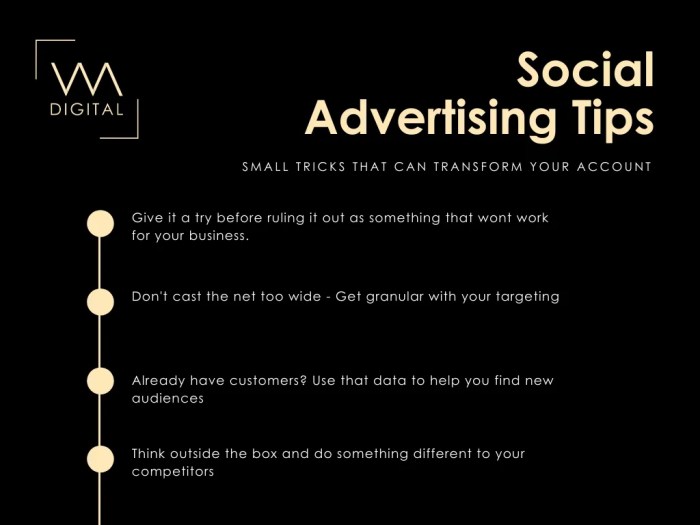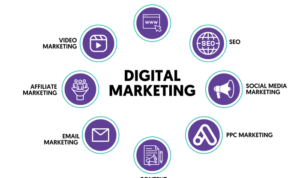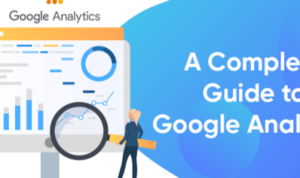Diving into Social Media Advertising Tips, get ready to boost your online presence and engagement with these cutting-edge strategies. From choosing the right platforms to creating killer ad content, this guide has got you covered.
Whether you’re a newbie or a seasoned pro, these tips will take your social media advertising game to the next level. Let’s dive in and revolutionize your marketing approach!
Importance of Social Media Advertising
In today’s digital age, social media advertising plays a crucial role in the success of businesses. With billions of users active on platforms like Facebook, Instagram, and Twitter, companies have a unique opportunity to reach a wide audience and engage with potential customers in a more personalized way.
Examples of Successful Social Media Advertising Campaigns
- Apple’s “Shot on iPhone” campaign showcased stunning user-generated content, highlighting the quality of iPhone cameras and generating buzz around the brand.
- Old Spice’s humorous and viral campaigns, featuring the “Old Spice Guy,” helped the brand reinvent its image and appeal to a younger audience.
- Dove’s “Real Beauty” campaign focused on empowering women and promoting self-acceptance, resonating with consumers and creating a strong emotional connection to the brand.
Impact of Social Media Advertising on Brand Awareness and Sales
Social media advertising has a significant impact on both brand awareness and sales. By creating targeted ads that reach specific demographics, businesses can increase brand visibility and attract new customers. Additionally, the interactive nature of social media allows for direct engagement with consumers, leading to higher brand loyalty and repeat purchases.
Choosing the Right Social Media Platforms
In the world of social media advertising, it’s crucial to choose the right platforms to reach your target audience effectively. Different social media platforms have distinct demographics and user behaviors, so selecting the best ones can make or break your advertising efforts.
Most Popular Social Media Platforms for Advertising
- Facebook: With over 2.7 billion monthly active users, Facebook remains a powerhouse for advertising, especially for reaching older demographics.
- Instagram: Popular among younger audiences, Instagram is great for visual content and influencer collaborations.
- Twitter: Known for real-time updates and news, Twitter can be effective for reaching a broad audience with trending topics.
- LinkedIn: Ideal for B2B marketing and professional networking, LinkedIn is perfect for targeting professionals and decision-makers.
- TikTok: Rising in popularity, TikTok is excellent for reaching Gen Z and creating engaging short videos.
Comparison of Audience Demographics
| Platform | Primary Demographics |
|---|---|
| Wide range of demographics, including older users | |
| Younger audience, especially under 35 years old | |
| Diverse audience with a focus on news and trends | |
| Professionals and decision-makers in various industries | |
| TikTok | Primarily Gen Z users interested in short-form videos |
Selecting the Best Platforms Based on Audience and Goals
- Identify your target audience: Understand the demographics, interests, and online behaviors of your audience to choose platforms where they are most active.
- Align with advertising goals: Consider the type of content you want to promote and the advertising objectives you aim to achieve on each platform.
- Test and analyze: Experiment with different platforms, analyze the performance metrics, and refine your strategy based on the results to optimize your advertising efforts.
Creating Engaging Ad Content

When it comes to social media advertising, creating engaging ad content is key to capturing the attention of your audience and driving results. From visually appealing graphics to compelling copywriting, every element plays a crucial role in the success of your ad campaigns.
Tips for Creating Visually Appealing Ad Content
- Use high-quality images and videos that are eye-catching and relevant to your target audience.
- Experiment with different colors, fonts, and visual elements to make your ads stand out in a crowded feed.
- Keep your design simple and clean to ensure that your message is easily understood at a glance.
- Create mobile-friendly ads that are optimized for viewing on smartphones and tablets.
The Importance of Compelling Copywriting in Social Media Ads
While visuals are essential, the copywriting in your ad content is equally important. A well-crafted message can compel users to take action and engage with your brand. Here are some key points to keep in mind:
- Write clear and concise headlines that grab attention and convey your value proposition.
- Use persuasive language to highlight the benefits of your product or service and create a sense of urgency.
- Include a strong call-to-action that tells users what you want them to do next, whether it’s to shop now, learn more, or sign up.
Examples of Successful Ad Content that Drives Engagement, Social Media Advertising Tips
Here are some examples of brands that have created engaging ad content that resonates with their audience:
-
“Just Do It” – Nike’s iconic slogan that motivates and inspires customers to push their limits.
-
“Share a Coke with…” – Coca-Cola’s personalized campaign that encouraged customers to connect with their loved ones by sharing a coke with their names on the bottle.
-
“Got Milk?” – The Dairy Association’s simple yet effective ad campaign that highlighted the importance of drinking milk.
Targeting the Right Audience: Social Media Advertising Tips
When it comes to social media advertising, targeting the right audience is crucial for the success of your ad campaigns. By reaching the right people with your message, you can increase engagement, drive conversions, and ultimately maximize your return on investment.
Different Targeting Options on Social Media Platforms
- Demographic Targeting: This includes factors such as age, gender, location, education, and income level. You can tailor your ads to specific demographics to ensure they resonate with your target audience.
- Interest Targeting: Social media platforms allow you to target users based on their interests, hobbies, and behaviors. This helps you connect with people who are more likely to be interested in your products or services.
- Behavioral Targeting: This involves targeting users based on their past behavior on social media, such as their interactions with ads, pages they’ve liked, or websites they’ve visited. By analyzing user behavior, you can refine your targeting to reach those most likely to convert.
- Custom Audiences: Many platforms offer the option to upload your own customer list or target users who have interacted with your business in some way. This allows you to re-engage existing customers or target prospects similar to your current customer base.
Strategies for Refining Audience Targeting
- Use Lookalike Audiences: Create lookalike audiences based on your existing customer data to find new users who share similar characteristics and behaviors. This can help you expand your reach to potential customers who are more likely to convert.
- Utilize Retargeting: Implement retargeting campaigns to reach users who have previously interacted with your brand but didn’t convert. By staying top of mind with these users, you can increase the chances of them completing a purchase.
- A/B Testing: Test different audience segments, messaging, and creative elements to see what resonates best with your target audience. By analyzing the results, you can optimize your campaigns for better performance.
- Monitor and Adjust: Regularly monitor the performance of your ad campaigns and make adjustments based on the data. By analyzing metrics such as click-through rates, conversion rates, and engagement, you can continuously refine your audience targeting for optimal results.
Setting Clear Advertising Objectives

Setting clear advertising objectives is crucial for the success of social media advertising campaigns. By defining specific goals, businesses can have a clear direction and focus on what they want to achieve. This helps in creating targeted and effective ads that resonate with the audience and drive desired results.
Importance of Setting Specific Goals
Setting specific goals ensures that the advertising campaign has a clear purpose and direction. Whether the objective is to increase brand awareness, drive website traffic, generate leads, or boost sales, having a specific goal allows businesses to tailor their ad content and targeting strategies accordingly.
- Increasing Brand Awareness: One common advertising objective is to increase brand awareness among the target audience. To achieve this, businesses can focus on creating engaging and shareable content that showcases their brand values and unique selling propositions.
- Driving Website Traffic: Another objective could be to drive traffic to the company website. In this case, businesses can create compelling ad copy with a clear call-to-action that encourages users to visit the website for more information or to make a purchase.
- Generating Leads: For businesses looking to generate leads, the objective could be to collect contact information from potential customers. This can be achieved by offering a lead magnet, such as a free e-book or webinar, in exchange for contact details.
- Boosting Sales: Increasing sales is often the ultimate goal of any advertising campaign. Businesses can set objectives related to driving conversions, such as making a purchase or signing up for a service.
Analyzing and Optimizing Ad Performance
In order to maximize the effectiveness of social media advertising, it is crucial to continuously analyze and optimize ad performance. By tracking key metrics and making data-driven decisions, you can ensure that your ads are reaching the right audience and achieving your advertising objectives.
Methods for Tracking and Analyzing Ad Performance Metrics
- Utilize social media analytics tools provided by platforms like Facebook Ads Manager, Instagram Insights, and Twitter Analytics to track metrics such as reach, engagement, and conversions.
- Set up UTM parameters to track the performance of your ads in Google Analytics, allowing you to monitor website traffic, conversions, and other important metrics.
- Regularly review and analyze ad performance data to identify trends, patterns, and areas for improvement.
Importance of A/B Testing in Optimizing Social Media Ads
- Conduct A/B tests by creating variations of your ad content, such as different images, copy, or calls to action, to determine which elements perform best with your target audience.
- Test one variable at a time to accurately assess the impact of changes and make informed decisions on optimizing ad performance.
- Use A/B testing to refine your ad strategy, increase engagement, and ultimately drive better results for your advertising campaigns.
Strategies for Making Data-Driven Decisions to Improve Ad Performance
- Regularly review ad performance data and metrics to identify top-performing ads and allocate budget towards those that are generating the best results.
- Use insights from analytics to refine targeting parameters, ad creatives, and messaging to better resonate with your target audience.
- Experiment with different ad formats, placements, and audience segments based on data analysis to optimize ad performance and achieve your advertising goals.
Budgeting and Scheduling Ad Campaigns
When it comes to social media advertising, setting an effective budget and scheduling ad campaigns strategically are crucial for maximizing your ROI and reaching your target audience effectively.
Setting an Effective Budget
- Start by defining your advertising objectives and determining how much you are willing to spend to achieve them.
- Consider factors such as the size of your target audience, the competitiveness of the platform, and the goals you want to achieve with your ads.
- Allocate your budget wisely across different social media platforms based on where your target audience is most active.
- Monitor your ad performance regularly and adjust your budget allocation based on the platforms that are delivering the best results.
Optimizing Ad Spending for Maximum ROI
- Utilize A/B testing to identify the most effective ad creatives, messaging, and targeting strategies that resonate with your audience.
- Focus on high-performing ads and reallocate budget from underperforming ones to maximize your ROI.
- Consider leveraging retargeting ads to reach users who have already shown interest in your products or services, increasing the likelihood of conversions.
- Use tools and analytics provided by social media platforms to track the performance of your ads and make data-driven decisions to optimize your spending.
Scheduling Ad Campaigns Effectively
- Identify the peak times when your target audience is most active on social media and schedule your ads to run during those times for maximum visibility.
- Consider the time zones of your target audience to ensure that your ads are reaching them at the right time, regardless of their location.
- Test different scheduling options and analyze the performance data to determine the most effective times to run your ad campaigns.
- Use scheduling tools provided by social media platforms to automate the timing of your ads and optimize your campaign schedule for better results.





